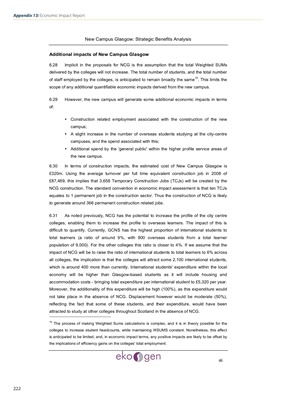
New Campus Glasgow: Strategic Benefits Analysis
46
Additional impacts of New Campus Glasgow
6.28 Implicit in the proposals for NCG is the assumption that the total Weighted SUMs
delivered by the colleges will not increase. The total number of students, and the total number
of staff employed by the colleges, is anticipated to remain broadly the same10
. This limits the
scope of any additional quantifiable economic impacts derived from the new campus.
6.29 However, the new campus will generate some additional economic impacts in terms
of:
• Construction related employment associated with the construction of the new
campus;
• A slight increase in the number of overseas students studying at the city-centre
campuses, and the spend associated with this;
• Additional spend by the 'general public' within the higher profile service areas of
the new campus.
6.30 In terms of construction impacts, the estimated cost of New Campus Glasgow is
£320m. Using the average turnover per full time equivalent construction job in 2008 of
£87,489, this implies that 3,658 Temporary Construction Jobs (TCJs) will be created by the
NCG construction. The standard convention in economic impact assessment is that ten TCJs
equates to 1 permanent job in the construction sector. Thus the construction of NCG is likely
to generate around 366 permanent construction related jobs.
6.31 As noted previously, NCG has the potential to increase the profile of the city centre
colleges, enabling them to increase the profile to overseas learners. The impact of this is
difficult to quantify. Currently, GCNS has the highest proportion of international students to
total learners (a ratio of around 9%, with 800 overseas students from a total learner
population of 9,000). For the other colleges this ratio is closer to 4%. If we assume that the
impact of NCG will be to raise the ratio of international students to total learners to 6% across
all colleges, the implication is that the colleges will attract some 2,100 international students,
which is around 400 more than currently. International students' expenditure within the local
economy will be higher than Glasgow-based students as it will include housing and
accommodation costs - bringing total expenditure per international student to £5,320 per year.
Moreover, the additionality of this expenditure will be high (100%), as this expenditure would
not take place in the absence of NCG. Displacement however would be moderate (50%),
reflecting the fact that some of these students, and their expenditure, would have been
attracted to study at other colleges throughout Scotland in the absence of NCG.
10 The process of making Weighted Sums calculations is complex, and it is in theory possible for the
colleges to increase student headcounts, while maintaining WSUMS constant. Nonetheless, this effect
is anticipated to be limited, and, in economic impact terms, any positive impacts are likely to be offset by
the implications of efficiency gains on the colleges' total employment.
222
Appendix 13: Economic Impact Report